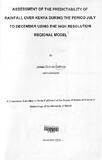| dc.description.abstract | This study assessed the skill of the High Resolution Regional Model (HRM) in
forecasting rainfall over Kenya over a period of six months from July 2008 to December
2008. In this study, observed rainfall data and HRM model output data were used.
Observed data for the twelve synoptic stations over Kenya were sourced from the
Kenya Meteorological Department. For HRM, the initial and lateral boundary data were
sourced from the Deutscher Wetterdienst (DWD), Germany. The model run was
initialized at 0000 UTC and forecast issued from the initial date to seven days (168 h)
and outputs produced at 24-hr intervals. To minimize boundary errors over the study
domain, the model domain covered the Tropical Africa region and its environs. The
model resolution was 14 km.
To determine the space-time variations of observed rainfall over Kenya, the
average rainfall for different stations was plotted for the period 1978 to 2007. The
resulting graphs with a representation of average monthly rainfall in millimeters against
time in months showed that most of the representative stations had at least two peaks
of rainfall in a year.
To determine the space-time variations of model rainfall forecasted over Kenya,
the spatial distribution of observed and forecasted rainfall of a few stations were done
and compared side by side. The results showed that in most cases HRM was
forecasting the areas to receive rainfall correctly but underestimated the amounts to be
received.
To determine the skill of HRM model in forecasting rainfall over Kenya, the Root
Mean Square Error (RMSE), Mean Absolute Error (MAE), Mean Error (ME), Correlation
and relative percentage error analyses were done.
The Root Mean Square Error (RMSE) results showed that the highest error of
21.4 was recorded over Kisumu while the least error of between 0 and 0.4 were
reported in the dry southeastern, northeastern and northwestern districts.
The results for Mean Absolute Error (MAE) also showed that the highest errors
were due to storms experienced at the stations concerned at various dates. The least
errors of between 0 and 0.4 were reported in most stations in the dry areas.
The results for Mean Error (ME) showed that all the highest errors in each
forecast day were negative meaning that the model was under forecasting in most
occasions.
Most of the results of the correlation showed positive correlation, which means
that HRM forecasts were in the same direction with the observed data.
These results indicated that the skill of HRM increased as the days progressed.
However, the skill improved for days three and five where the Model could capture the
signal and not necessarily the magnitude. The results of the relative percentage error
indicated that HRM was more skillful over the Western part of Kenya and least skillful
over the dry region of the country.
With proper adjustment of schemes for modeling cloud microphysics in HRM, the
model has the ability to correctly forecast storms and heavy rainfall over the region.
It is therefore strongly recommended that some improvement on the physics of
the model is necessary and more computer resources should be deployed when setting
up the HRM for further work on the study. A similar study on HRM in the neighbouring
countries is also recommended. | en |

